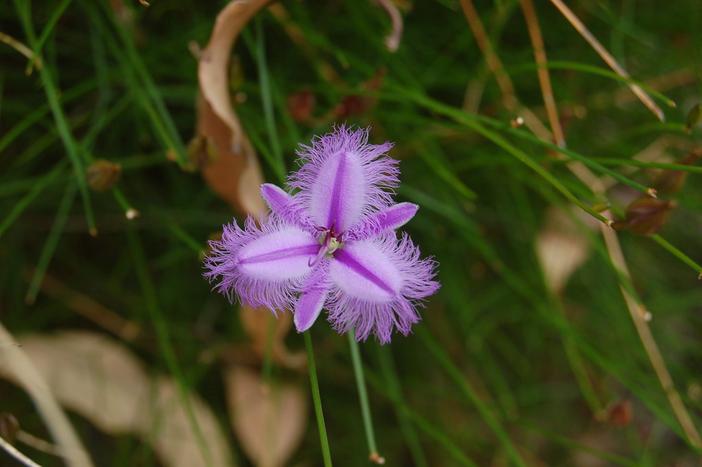Fringe Lily
(Thysanotus multiflorus)
Fringe Lily (Thysanotus multiflorus)
/
/

Anna Gardiner
PDM 1.0
Image By:
Anna Gardiner
Recorded By:
Copyright:
PDM 1.0
Copyright Notice:
Photo by: Anna Gardiner | License Type: PDM 1.0 | License URL: https://creativecommons.org/publicdomain/mark/1.0/ | Uploader: odd.organisms | Publisher: Flickr




































Estimated Native Range
Summary
Thysanotus multiflorus, commonly known as Fringe Lily, is a semi-deciduous perennial herb native to a variety of habitats including open woodlands, heathlands, and coastal dunes in Southwestern Australia. It typically grows to a height of 1 foot (0.3 meters) and a width of 0.7 feet (0.2 meters). The Fringe Lily is notable for its unique three-petaled flowers, which are fringed on the edges and exhibit vibrant shades of pink and purple. These flowers bloom profusely in the spring and summer and are quite showy, attracting pollinators such as bees.
The Fringe Lily is valued for its ornamental flowers and is used in cultivation for border planting, rockeries, and as a feature in native gardens. It is relatively easy to maintain, requiring minimal water once established, making it suitable for xeriscaping. It thrives in well-drained soils, preferring sandy to loamy textures, and can tolerate both full sun and part shade. While it is not known for having aggressive roots or being particularly prone to diseases, it can be sensitive to overwatering and root rot. The Fringe Lily does not have widespread cultivars due to its preference for specific climates and soil types.CC BY-SA 4.0
The Fringe Lily is valued for its ornamental flowers and is used in cultivation for border planting, rockeries, and as a feature in native gardens. It is relatively easy to maintain, requiring minimal water once established, making it suitable for xeriscaping. It thrives in well-drained soils, preferring sandy to loamy textures, and can tolerate both full sun and part shade. While it is not known for having aggressive roots or being particularly prone to diseases, it can be sensitive to overwatering and root rot. The Fringe Lily does not have widespread cultivars due to its preference for specific climates and soil types.CC BY-SA 4.0
Plant Description
- Plant Type: Herb
- Height: 1-1.5 feet
- Width: 0.467-0.7 feet
- Growth Rate: Moderate
- Flower Color: Purple
- Flowering Season: Spring, Summer
- Leaf Retention: Semi-Deciduous
Growth Requirements
- Sun: Full Sun, Part Shade
- Water: Low, Medium
- Drainage: Fast, Medium
Common Uses
Drought Tolerant, Low Maintenance, Showy Flowers
Natural Habitat
Open woodlands, heathlands, and coastal dunes
Other Names
Common Names:
Scientific Names: , Thysanotus multiflorus, Chlamysporum multiflorum, Thysanotus brevipes, Thysanotus multiflorus var. prolifer, Thysanotus prolifer, Thysanotus proliferus,
GBIF Accepted Name: Thysanotus multiflorus R.Br.